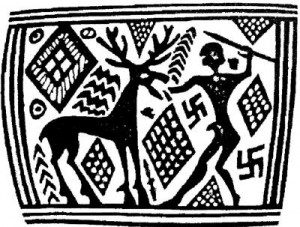Part 5
 This magical use of symbols is typical of Hermetism and of the rituals of some organizations that have been partially influenced by it. It grafts itself onto the practice of ritual that leads to the fulfillment of the Work.
This magical use of symbols is typical of Hermetism and of the rituals of some organizations that have been partially influenced by it. It grafts itself onto the practice of ritual that leads to the fulfillment of the Work.
The Hermetic tradition that states that only one vessel is sufficient to complete the Work, or at most two (as apparently happened in Flamel’s case). This vessel, the “Philosophers'” athanor, needs to be sealed hermetically or, according to Hermetic ritual (the expression “hermetic sealing” has remained to this day to designate the corresponding chemical operation), in order to be able to operate within it, after isolating it from the outside. According to a well-known Hermetic saying, “Visita interiora terrae, rectificando invenies occultam lapidem” [Visit the interior of the earth. By rectification you will find the hidden stone] (Basil Valeninus, Aurelia occulta philosophorum, 2nd ed., 1613; it can also be found earlier in a slightly different form). The vessel, the grasale or chalice of the Holy Grail, is in facto of “earth’; but “earth,” according to an archaic symbolism found in many languages, is the human body. Human beings (from humus, “earth”) are earthly, terrestrial creatures; their body is molded with the mud of the earth (see the etymology of Adam), which is their dwelling place (see the German term Boden, “ground”; and the English terms body and abode). By visiting the inside of this vessel and rectifying (another technical term retained in chemistry to designate the corresponding operation) one finds the “Philosophers’ Stone.”
 Cardinal Nicholas of Cusa (1401-1464) says (Opera, Basel, 1563, p.632) that the master descends from Jerusalem to the rough mountains of the desert in order to cut and shape stones for the holy edifice (the place for beholding the gods), and that the soul, chosen as the bride for the son of God who dwells in immortality, adapts itself to the transformation sicut lapides poliuntur (as stones are polished)— that is, as the stones were smoothed that were to be employed in building the Temple of Jerusalem in which the theophany occurs. This edifying symbolism of Nicholas of Cusa corresponds precisely to later Masonic symbolism, in which the workers (the “fellows”) polish the stones, square them, and form the cubic stone, or perfect stone, in the “inner chamber.” Dante at the beginning of his De vita nova says: “Truthfully, I declare that the spirit of life resides in the most secret chamber of the heart.” If the Hermetic vessel and earth are none other than the human organism, then the interior of the earth, the “heart” of the organism, can only be the heart. The heart is the sanctuary or crypt of the temple, portrayed as beneath the ground in the crypt of ancient temples. We can understand why an ancient anonymous French alchemist explained the name of the Saint Graal with the incorrect, though significant, etymology of sang real, or “royal blood.” Such a connection of the vessel with the heart can be traced all the way to ancient Egypt, since the ideogram of the heart is a vase with two ear-shaped handles (the ears of the heart); the similarity between heart and athanor is interesting, especially when we recall the Egyptian origin of the Hermetic tradition.
Cardinal Nicholas of Cusa (1401-1464) says (Opera, Basel, 1563, p.632) that the master descends from Jerusalem to the rough mountains of the desert in order to cut and shape stones for the holy edifice (the place for beholding the gods), and that the soul, chosen as the bride for the son of God who dwells in immortality, adapts itself to the transformation sicut lapides poliuntur (as stones are polished)— that is, as the stones were smoothed that were to be employed in building the Temple of Jerusalem in which the theophany occurs. This edifying symbolism of Nicholas of Cusa corresponds precisely to later Masonic symbolism, in which the workers (the “fellows”) polish the stones, square them, and form the cubic stone, or perfect stone, in the “inner chamber.” Dante at the beginning of his De vita nova says: “Truthfully, I declare that the spirit of life resides in the most secret chamber of the heart.” If the Hermetic vessel and earth are none other than the human organism, then the interior of the earth, the “heart” of the organism, can only be the heart. The heart is the sanctuary or crypt of the temple, portrayed as beneath the ground in the crypt of ancient temples. We can understand why an ancient anonymous French alchemist explained the name of the Saint Graal with the incorrect, though significant, etymology of sang real, or “royal blood.” Such a connection of the vessel with the heart can be traced all the way to ancient Egypt, since the ideogram of the heart is a vase with two ear-shaped handles (the ears of the heart); the similarity between heart and athanor is interesting, especially when we recall the Egyptian origin of the Hermetic tradition.